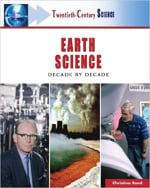A Brief History of Earth Sciences: 2000-2020

We explore the field of earth science from 2000-2020.
In 2007, the Intergovernmental Panel on Climate Change (IPCC) reported an alarming finding: t CO2 levels in the atmosphere, which had reached 379 ppm by 2005, were higher than they had been in the past 650,000 years. The environmental movement, which had coelesed in the 1960s in response to Rachel Carson’s book Silent Spring, was ready to take on this challenge. Former U.S. Vice President Al Gore’s 2006 documentary An Inconvenient Truth was a catalyst for turning the public’s attention to this newly discovered threat. The subsequent decade and a half, indeed up to the present time, has thrust earth scientists into the public eye like never before.


As early as 1827, scientists had known that atmospheric CO2 worked to keep the earth warmer than it would be in its absence. Later in the 1800′s, Svante Arrhenius (1859-1927) estimated that the earth is 5 to 10°C warmer thanks to CO2 and that, if CO2 levels were doubled, the earth would warm significantly. Few people, certainly not Arrhenius, would have predicted that humans would release ten-times more CO2 annually into the atmosphere at the end of the 20th century than at its beginning.
Charles David Keeling (1928-2005) and the Mauna Loa Observatory in Hawaii played a big role in alerting the world to the rising levels of CO2 in the atmosphere. Starting in 1958, Keeling took careful CO2 measurements and found the initial concentration to be 315 ppm and that the concentration was rising each year (as of this writing it is now over 415 ppm). The Keeling Curve, as the graph and predictions of his measurements became known, has proved an iconic symbol of the effect humans are having on the climate of our planet.
Interested in diving a little deeper, check out our look at the Climate Change Controversy.
While Global Warming or Climate Change—the more popular term since the late 1990′s—has dominated people’s perception of Earth Science over the past two decades, a number of other advancements have been made. For example, at the 2018 Subduction Zone Observatory Workshop, a network of researchers banded together under the SZ4D vision as a way to mitigate potential geohazards such as earthquakes, tsunamis, landslides, and volcanic eruptions. As another example, the spacecraft Cassini orbited Saturn from 2004 until 2017, discovering aspects of Earth Science that would not be applicable to our own planet, such as the process that feeds new material into Saturn’s rings.
Meanwhile, thanks to the dedicated public outreach efforts of countless scientists and the public response they ignited and encouraged, the ozone hole over Antarctica began its healing process; in 2019 the hole was the smallest it had been since it was first discovered in 1985. On the other hand, unauthorized emissions of ozone-depleting substances in China may have contributed to the hole increasing in size in 2020 and 2021.
In the past two decades, one innovation dominated all the sciences, and the Earth Sciences were no exception: the World Wide Web. Interestingly, the technology which makes this web possible—the internet—is susceptible to the electromagnetic pulses from large solar events. In 1859, the Carrington Event was just such an event, knocking out telegraph systems across the world, and a similar event happened in 2012 but missed our planet by only nine days. Had it made a direct hit, or had the Carrington Event happened in modern times, the results would have been a massive shutdown of all that keeps our societies functioning. This sober truth is a reminder that our civilization is always at the mercy of the events that earth scientists study and that we need to continually strive to better understand the world around us.
Find out which influencers have most contributed to advancing the field of Earth Sciences over the last two decades with a look at The Most Influential People in Earth Sciences, for the years 2000–2020.
And to find out which schools are driving the Earth Sciences field forward today, check out The Most Influential Schools in Earth Sciences for the years 2000-2020.
Or, continue exploring the fascinating history of the Earth Sciences discipline with a look back at the field before the start of the 20th Century.
Get more study tips, learning tools, and study starters with a look out our Complete Library of Study Guides.
Or jump to our student resource library for tips on everything from studying to starting on your career path.